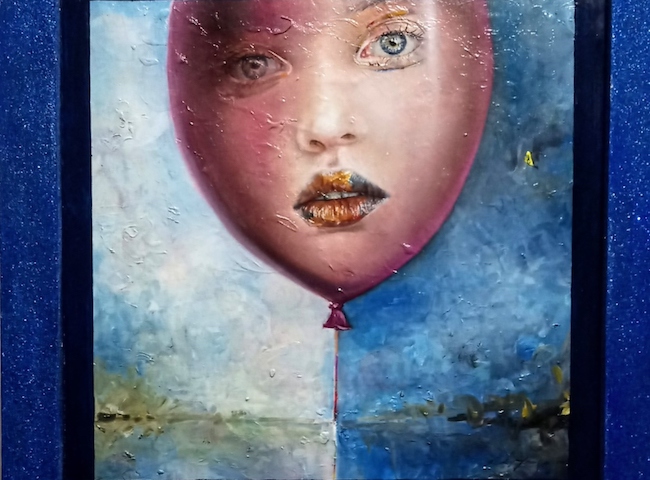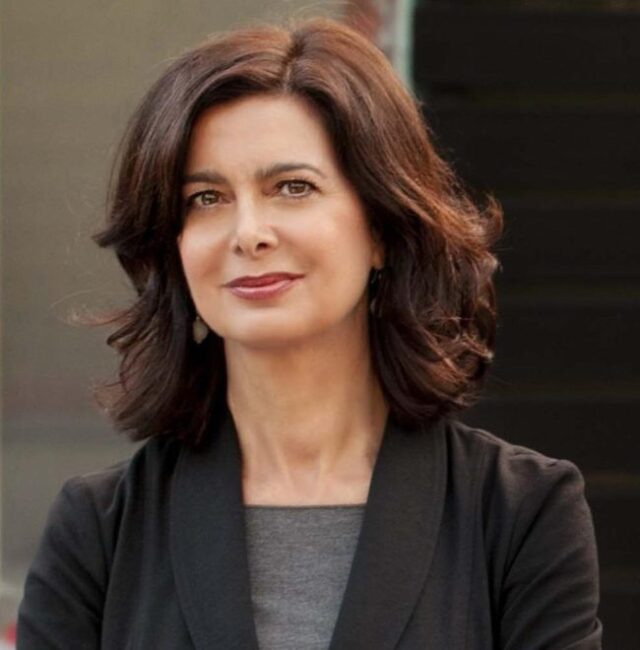Lo sguardo sulla contemporaneità e le sue caratteristiche a volte disorientanti altre confuse e poco lineari, contraddistingue la ricerca di molti artisti che all’interno di quelle destabilizzazioni e delle insicurezze che avvolgono l’essere umano, trovano la poetica della propria creatività mostrando un bisogno di esplorazione e di comprensione di tutto ciò che appartiene all’interiorità. L’artista di cui vi racconterò oggi compie un vero e proprio viaggio nell’animo delle sue protagoniste, prevalentemente donne, che cercano di ricomporre la realtà sfaccettata del loro vissuto per trovare una nuova identità.
Nel corso dei primi decenni del Novecento, quel periodo artistico dinamico e rivoluzionario in cui tutte le certezze e le regole accademiche precedenti furono sovvertite dai venti di novità e dal desiderio di rompere con un passato non più adeguato ai tempi in costante evoluzione, si andò affermando, tra i tanti movimenti artistici che vollero rifiutare la figurazione e l’attinenza alla realtà osservata, una corrente che al contrario fece del gioco tra reale e irreale, della confusione nello sguardo che doveva trovarsi di fronte a un mondo a metà tra sogno e realtà, una delle sue linee guida. Ispirato dalle ricerche psichiatriche sugli incubi vissuti dai reduci della Prima Guerra Mondiale condotti da Sigmund Freud, il Surrealismo attingeva alla figurazione per rappresentare un mondo parallelo, possibile perché elaborato dalla mente sulla base delle conoscenze e delle esperienze osservate ma al tempo stesso impossibile poiché legato a paure, fragilità, inganni della ragione che conducevano all’interno di luoghi non luoghi dove si concretizzavano gli incubi e i timori affioranti durante la fase del sonno. Le immagini liquefatte e inquietanti di Salvador Dalì mostravano le debolezze umane, le angosce del vivere e l’ansia per il passare inesorabile del tempo che coincidevano con le stesse paure dell’artista, fuori dagli schemi e ingestibile tanto quanto conturbanti erano i suoi capolavori; così come i paesaggi apocalittici delle tele di Max Ernst evidenziano il timore del futuro, l’incertezza di un mondo dove niente era più come era stato fino a poco prima e così emergono le angosce e i turbamenti che trasformano la realtà osservata in un mondo spaventoso pieno di figure mostruose a raffigurare l’aggressività dell’uomo e la distruzione di cui è capace. E poi le opere misteriose, più metafisiche, di René Magritte che sovvertono l’ordine delle cose pur lasciandole galleggiare nella realtà, inducendo l’osservatore a interrogarsi su se stesso, sui propri percorsi mentali, sui dubbi e sulle debolezze del proprio animo.
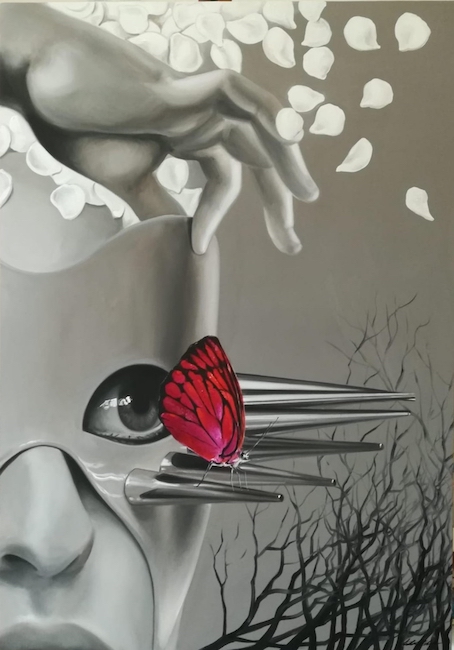
Il medesimo approccio esplorativo sul mondo interiore, sul cammino esistenziale e sulla necessità di andare in profondità in un mondo in cui tutto sembra dover restare in superficie, è quello adottato dall’artista romana Federica Fedele, che giunge al Surrealismo dopo un periodo di sperimentazione seguito agli studi accademici che l’hanno condotta a desiderare di misurarsi con il concetto oltre alla costruzione estetica di un’opera; il passaggio attraverso la figurazione iperrealista, pur sempre destabilizzata verso una realtà significata piuttosto che semplicemente riprodotta, conferisce alle sue opere un sapore familiare, di oggetti e situazioni conosciute perché appartenenti alla quotidianità, eppure enigmatiche in virtù della decontestualizzazione che contraddistingue la composizione della tela. Le donne protagoniste delle opere di Federica Fedele, si interrogano su se stesse, sulle proprie motivazioni profonde, sui ricordi, sulle fragilità da superare perché non c’è mai accettazione passiva dello stato delle cose bensì il desiderio di andare oltre, di superare i propri limiti interiori e percorrere un nuovo cammino alla luce delle raggiunte consapevolezze.
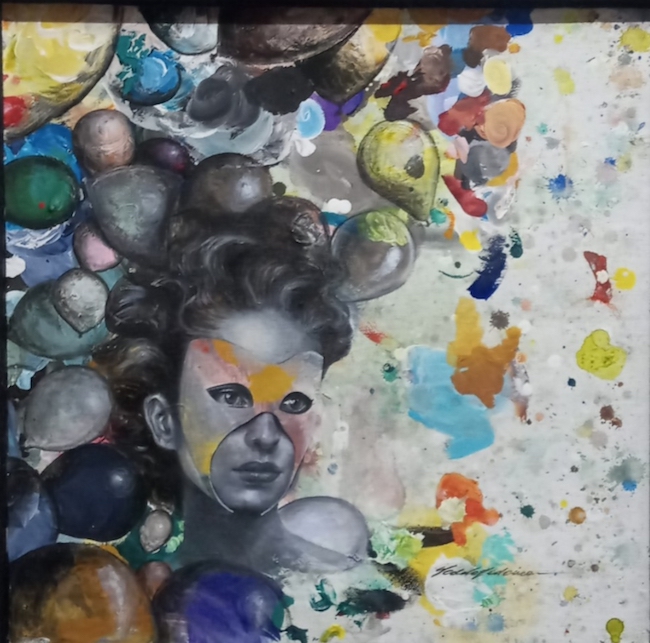
Dal punto di vista tecnico Federica Fedele ha un approccio esplorativo, ama misurarsi con supporti non tradizionali costituiti da materiali differenti e stratificati, tanto quanto sovrapposti sono i livelli di colore a rappresentare un’esistenza costituita da esperienze che si sommano le une alle altre generando la personalità presente che non potrà che essere inferiore e meno ricca di quella futura; sulle basi da lei stessa composte ritrae con la pittura a olio, volti femminili che esprimono tutta la forza, la determinazione, l’autoconsapevolezza e la ricerca di sé che contraddistinguono la donna contemporanea.
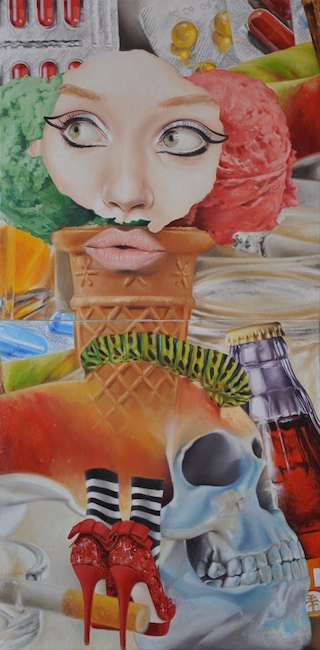
Nella tela My mind is an apple (La mia mente è una mela), la Fedele gioca con i simboli degli eccessi a cui la società è continuamente sottoposta, quel correre verso l’inconsapevole autodistruzione con leggerezza disarmante, al punto che la protagonista sembra volersi proteggere all’interno di qualcosa di più sano, un semplice gelato, piuttosto che perdersi in un mondo di fumo, di pillole, di inseguimento di tutto ciò che è effimero e che distoglie da una naturalezza necessaria per mantenersi legati all’autenticità.

In Change (Cambiamento) l’artista sottolinea la capacità, che è anche un’esigenza, di modificarsi costantemente e di adeguarsi alla realtà circostante, esattamente come il camaleonte posto sulla testa della protagonista, non per mancanza di carattere bensì per essere in grado di affrontare ogni circostanza, ogni interazione, senza soccombere, senza mostrare una rigidità che potrebbe essere controproducente; sul lato sinistro della tela un hot dog, appartenente ai cibi cosiddetti spazzatura, che si contrappone all’immagine pulita e sana della donna protagonista, quasi come se ella stessa abbia dovuto combattere una battaglia per allontanarsi dalla tentazione di ciò che sapeva non farle bene, non essere salutare per il proprio equilibrio psico-fisico.
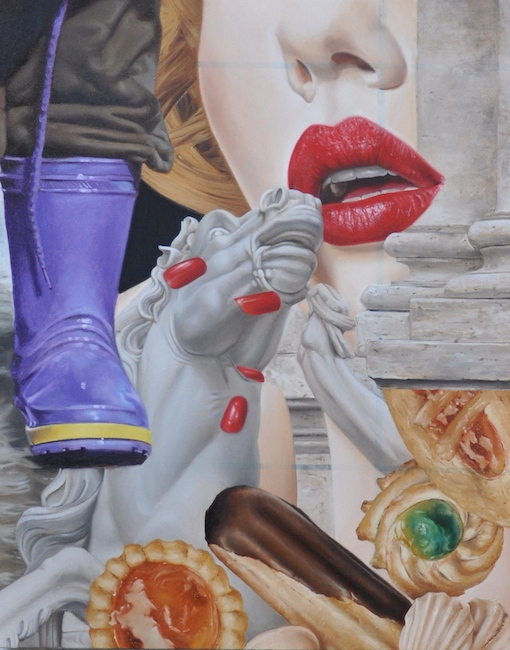
Il rapporto con il cibo è importante per Federica Fedele, è come se fosse un contatto con il bisogno primordiale di nutrirsi che spesso però tende a divenire un modo per superare ansie, paure, insicurezze, per riempire un vuoto emotivo, per segnare episodi della vita da dimenticare o da ricordare; nel dipinto Sweet life (Dolce vita) infatti lega i dolci alla perdita di certezze della società contemporanea che appare distante dai valori più classici, rappresentati dalle colonne e dal cavallo di tempi in cui tutto era meno complesso e articolato, e li allinea all’attenzione all’esteriorità, all’estetica fine a se stessa di unghie laccate, di labbra rosse che spesso nascondono malinconie e tristezze inconfessabili perché troppo rivelatorie di un’interiorità insicura e fragile.
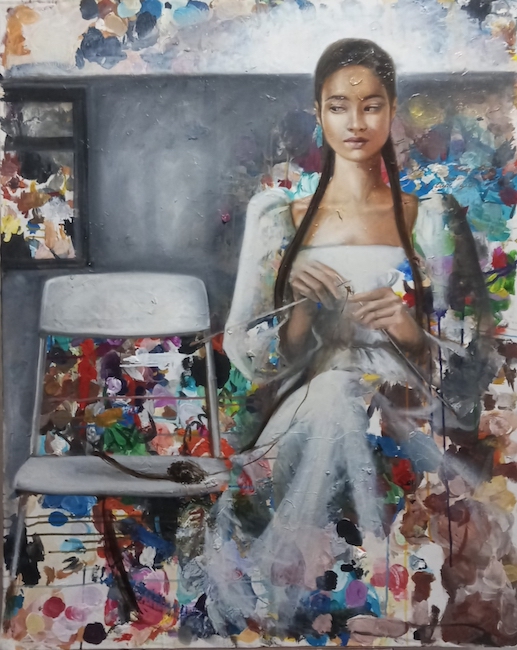
In Attesa di te (stessa) Federica Fedele pone la protagonista al centro della tela, seduta e intenta a lavorare ai ferri come se quel comporre maglia dopo maglia fosse una metafora della crescita personale, quel doversi fermare a riflettere sugli eventi, sugli accadimenti che generano inevitabilmente cambiamenti e trasformazioni funzionali alla conoscenza di sé; lo sguardo della donna è determinato, fiero, non vi è timore né tanto meno destabilizzazione in quell’attesa, sembra quasi che sia consapevole della pazienza necessaria per intraprendere un percorso evolutivo e della capacità di osservare e di interrogarsi per procedere e comprendere quale sia la direzione migliore, quella che solo a seguito dell’esperienza può svelarsi.

Uno stile pittorico particolare dunque, un’interpretazione moderna del Surrealismo laddove non viene evidenziato il mondo delle inquietudini e degli incubi bensì la ricerca delle debolezze del vivere contemporaneo osservate con sguardo ironico ma al tempo stesso realisticamente profondo e intenso. Federica Fedele ha partecipato a molte mostre collettive nella città di Roma ricevendo apprezzamento dal pubblico e dagli addetti ai lavori.
FEDERICA FEDELE-CONTATTI
Email: ffedele2811@gmail.com
Facebook: https://www.facebook.com/federica.fedele.182
Federica Fedele’s hyperrealist artworks, between metaphysics and the surreal sense of existence
A look at the contemporary world and its sometimes disorienting, sometimes confusing and non-linear characteristics highlights the research of many artists who find the poetics of their creativity within the destabilisation and insecurities that envelop the human being, showing a need to explore and understand everything that belongs to the inner self. The artist I am going to tell you about today takes a real journey into the souls of his protagonists, mainly women, who try to recompose the multifaceted reality of their lives in order to find a new identity.
During the first decades of the twentieth century, that dynamic and revolutionary artistic period in which all the previous certainties and academic rules were subverted by the winds of novelty and the desire to break with a past that was no longer suited to the constantly evolving times, there emerged, among the many artistic movements that wanted to reject figuration and its relevance to observed reality, a current that, on the contrary, made the play between the real and the unreal, the confusion in the eye that had to face a world halfway between dream and reality, one of its guidelines. Inspired by psychiatric research into the nightmares experienced by veterans of the First World War conducted by Sigmund Freud, Surrealism drew on figuration to represent a parallel world, possible because it was elaborated by the mind on the basis of knowledge and observed experiences, but at the same time impossible because it was linked to fears, fragility and deceptions of reason that led to places that were not places, where the nightmares and fears that surfaced during sleep took shape.
Salvador Dali’s liquefied and disturbing images showed human weaknesses, the anxieties of life and anxiety about the inexorable passing of time, which coincided with the artist’s own fears, as unconventional and unmanageable as his masterpieces were disturbing; just as the apocalyptic landscapes of Max Ernst’s canvases highlight the fear of the future, the uncertainty of a world where nothing was as it had been until a short time ago, and thus the anxieties and disturbances that transform the reality observed into a frightening world full of monstrous figures depicting man’s aggressiveness and the destruction of which he is capable to emerge. And then there are the mysterious, more metaphysical paintings of René Magritte that subvert the order of things while letting them float in reality, leading the observer to question himself, his own mental paths, the doubts and weaknesses of his soul. The same exploratory approach to the inner world, to the existential journey and the need to go deep in a world where everything seems to have to remain on the surface, is adopted by the Roman artist Federica Fedele, who came to Surrealism after a period of experimentation following her academic studies, which led her to wish to measure herself against the concept as well as the aesthetic construction of a work; the passage through hyper-realist figuration, though always destabilised towards a reality that is signified rather than simply reproduced, gives her artworks a familiar flavour, of objects and situations that are familiar because they belong to everyday life, yet enigmatic by virtue of the decontextualisation that characterises the composition of the canvas.
The women in Federica Fedele’s paintings question themselves, their deepest motivations, their memories, the fragilities they have to overcome, because there is never a passive acceptance of the state of things, but rather a desire to go further, to overcome their own interior limits and take a new path in the light of the awareness they have achieved. From a technical point of view, Federica Fedele has an exploratory approach, she loves to measure herself against non-traditional supports made up of different and stratified materials, as much as the layers of colour are superimposed to represent an existence made up of experiences that add up to each other, generating the present personality which can only be inferior and less rich than the future one; on the bases she has composed herself, she portrays, with oil painting, female faces that express all the strength, determination, self-awareness and self-searching that distinguish contemporary women. In the canvas My mind is an apple, Fedele plays with the symbols of the excesses to which society is continually subjected, running towards unconscious self-destruction with disarming lightness, to the point that the protagonist seems to want to protect herself with something healthier, a simple ice cream, rather than losing herself in a world of smoke, pills, and the pursuit of all that is ephemeral and distracts from a naturalness that is necessary to maintain authenticity.
In Change the artist emphasises the ability, which is also a need, to constantly change and adapt to the surrounding reality, just like the chameleon on the head of the protagonist, not for lack of character but to be able to deal with all circumstances, all interactions, without succumbing, without showing a rigidity that could be counterproductive; on the left side of the canvas, a hot dog, one of the so-called junk foods, which contrasts with the clean and healthy image of the woman protagonist, almost as if she herself had had to fight a battle to get away from the temptation of what she knew was not good for her, not healthy for her psycho-physical balance. The relationship with food is important to Federica Fedele, as if it were a contact with the primordial need to feed oneself, which often tends to become a way of overcoming anxieties, fears, insecurities, of filling an emotional void, of marking episodes in life to be forgotten or remembered; in the painting Sweet life, in fact, sweets are linked to the loss of certainties in contemporary society, which seems distant from the more classical values represented by columns and horses in times when everything was less complex and articulated, and aligns them with attention to the exterior, to the aesthetics of lacquered nails and red lips that often conceal unmentionable melancholy and sadness because they are too revealing of an insecure and fragile interiority.
In Attesa di te (stessa) Federica Fedele places the protagonist at the centre of the canvas, seated and intent on knitting, as if that mesh after mesh were a metaphor for personal growth, that having to stop and reflect on events, on happenings that inevitably generate changes and transformations that are functional to self-knowledge; the woman’s gaze is determined, proud, there is no fear or destabilisation in that wait, it almost seems as if she is aware of the patience needed to undertake a path of evolution and the ability to observe and question herself in order to proceed and understand which is the best direction, the one that can only be revealed after experience. A particular pictorial style then, a modern interpretation of Surrealism where the world of anxieties and nightmares is not highlighted but rather the search for the weaknesses of contemporary life observed with an ironic but at the same time realistically deep and intense gaze. Federica Fedele has taken part in many group exhibitions in Rome, receiving appreciation from both the public and professionals.


